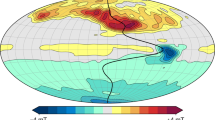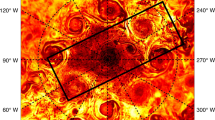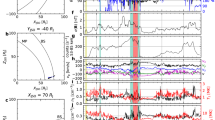Abstract
The bands of Jupiter represent a global system of powerful winds. Broad eastward equatorial jets are flanked by smaller-scale, higher-latitude jets flowing in alternating directions1,2. Jupiter's large thermal emission suggests that the winds are powered from within3,4, but the zonal flow depth is limited by increasing density and electrical conductivity in the molecular hydrogen–helium atmosphere towards the centre of the planet5. Two types of planetary flow models have been explored: shallow-layer models reproduce multiple high-latitude jets, but not the equatorial flow system6,7,8, and deep convection models only reproduce an eastward equatorial jet with two flanking neighbours9,10,11,12,13,14. Here we present a numerical model of three-dimensional rotating convection in a relatively thin spherical shell that generates both types of jets. The simulated flow is turbulent and quasi-two-dimensional and, as observed for the jovian jets, simulated jet widths follow Rhines' scaling theory2,12,13,15. Our findings imply that Jupiter's latitudinal transition in jet width corresponds to a separation between the bottom-bounded flow structures in higher latitudes and the deep equatorial flows.
This is a preview of subscription content, access via your institution
Access options
Subscribe to this journal
Receive 51 print issues and online access
$199.00 per year
only $3.90 per issue
Buy this article
- Purchase on Springer Link
- Instant access to full article PDF
Prices may be subject to local taxes which are calculated during checkout



Similar content being viewed by others
References
Porco, C. C. et al. Cassini imaging of Jupiter's atmosphere, satellites and rings. Science 299, 1541–1547 (2003)
Vasavada, A. R. & Showman, A. P. Jovian atmospheric dynamics: an update after Galileo and Cassini. Rep. Prog. Phys. 68, 1935–1996 (2005)
Ingersoll, A. P. Pioneer 10 and 11 observations and the dynamics of Jupiter's atmosphere. Icarus 29, 245–253 (1976)
Pirraglia, J. A. Meridional energy balance of Jupiter. Icarus 59, 169–176 (1984)
Guillot, T., Stevenson, D. J., Hubbard, W. & Saumon, D. in Jupiter, the Planet, Satellites and Magnetosphere (eds Bagenal, F., Dowling, T. E. & McKinnon, W. B.) 35–57 (Cambridge Univ. Press, Cambridge, 2004)
Cho, J. Y.-K. & Polvani, L. M. The morphogenesis of bands and zonal winds in the atmospheres on the giant outer planets. Science 273, 335–337 (1996)
Williams, G. P. Planetary circulations. 1. Barotropic representation of Jovian and terrestrial turbulence. J. Atmos. Sci. 35, 1399–1426 (1978)
Williams, G. P. Jovian dynamics. Part III: Multiple, migrating, and equatorial jets. J. Atmos. Sci. 60, 1270–1296 (2003)
Aurnou, J. M. & Olson, P. L. Strong zonal winds from thermal convection in a rotating spherical shell. Geophys. Res. Lett. 28, 2557–2559 (2001)
Christensen, U. R. Zonal flow driven by deep convection on the major planets. Geophys. Res. Lett. 28, 2553–2556 (2001)
Christensen, U. R. Zonal flow driven by strongly supercritical convection in rotating spherical shells. J. Fluid Mech. 470, 115–133 (2002)
Yano, J. I., Talagrand, O. & Drossart, P. Origins of atmospheric zonal winds. Nature 421, 36 (2003)
Yano, J. I., Talagrand, O. & Drossart, P. Deep two-dimensional turbulence: An idealized model for atmospheric jets of the giant outer planets. Geophys. Astrophys. Fluid Dyn. 99, 137–150 (2005)
Aurnou, J. M. & Heimpel, M. H. Zonal jets in rotating convection with mixed mechanical boundary conditions. Icarus 169, 492–498 (2004)
Ingersoll, A. P. Atmospheric dynamics of the outer planets. Science 248, 308–315 (1990)
Rhines, P. B. Waves and turbulence on a beta-plane. J. Fluid Mech. 69, 417–443 (1975)
Schoff, R. & Colin de Verdiere, A. Taylor columns between concentric spheres. Geophys. Astrophys. Fluid Dyn. 86, 43–73 (1997)
Busse, F. H. A simple model of convection in the Jovian atmosphere. Icarus 20, 255–260 (1976)
Manneville, J. B. & Olson, P. Banded convection in rotating fluid spheres and the circulation of the Jovian atmosphere. Icarus 122, 242–250 (1996)
Jones, C. A., Rotvig, J. & Abdulrahman, A. Multiple jets and zonal flow on Jupiter. Geophys. Res. Lett. 30, doi:10.1029/2003GL016980 (2003)
Read, P. L. et al. Jupiter's and Saturn's convectively driven banded jets in the laboratory. Geophys. Res. Lett. 31, doi:10.1029/2004GL020106 (2004)
Atkinson, D. H., Pollack, J. B. & Seiff, A. The Galileo Probe Doppler Wind Experiment: Measurement of the deep zonal winds on Jupiter. J. Geophys. Res. 103, 22911–22928 (1998)
Kirk, R. L. & Stevenson, D. J. Hydromagnetic constraints on deep zonal flow in the giant planets. Astrophys. J. 316, 836–846 (1987)
Aubert, J., Brito, D., Nataf, H.-C., Cardin, P. & Masson, J. P. A systematic experimental study of spherical shell convection in water and liquid gallium. Phys. Earth. Planet. Inter. 128, 51–74 (2001)
Evonuk, M. & Glatzmaier, G. A. 2D studies of various approximations used for modeling convection in the giant planets. Geophys. Astrophys. Fluid Dyn. 98, 241–255 (2004)
Hubbard, W. B. Gravitational signature of Jupiter's deep zonal flows. Icarus 137, 357–359 (1999)
Martinez, C. NASA selects new frontier mission concept study. http://www.jpl.nasa.gov/news/news.cfm?release=2005-090 (2005).
Wicht, J. Inner-core conductivity in numerical dynamo simulations. Phys. Earth Planet. Inter. 132, 281–302 (2002)
Al-Shamali, F. M., Heimpel, M. H. & Aurnou, J. M. Varying the spherical shell geometry in rotating thermal convection. Geophys. Astrophys. Fluid Dyn. 98, 153–169 (2004)
Kuang, W.-J. & Bloxham, J. Numerical modeling of magnetohydrodynamic convection in a rapidly rotating spherical shell: Weak and strong field dynamo action. J. Comp. Phys. 153, 51–81 (1999)
Acknowledgements
Funding was provided by NSERC Canada, UCLA, and the DFG Germany priority programme ‘Geomagnetic variations’. Computational resources were provided by the Western Canada Research Grid (West Grid).
Author information
Authors and Affiliations
Corresponding author
Ethics declarations
Competing interests
Reprints and permissions information is available at npg.nature.com/reprintsandpermissions. The authors declare no competing financial interests.
Supplementary information
Supplementary Notes
This file contains Supplementary Results, Supplementary Discussion, Supplementary Figures 1–4 and Supplementary Table 1. (PDF 465 kb)
Rights and permissions
About this article
Cite this article
Heimpel, M., Aurnou, J. & Wicht, J. Simulation of equatorial and high-latitude jets on Jupiter in a deep convection model. Nature 438, 193–196 (2005). https://doi.org/10.1038/nature04208
Received:
Accepted:
Issue Date:
DOI: https://doi.org/10.1038/nature04208
This article is cited by
-
A rapidly time-varying equatorial jet in Jupiter’s deep interior
Nature (2024)
-
Observational evidence for cylindrically oriented zonal flows on Jupiter
Nature Astronomy (2023)
-
Statistics of temperature and velocity fluctuations in supergravitational convective turbulence
Acta Mechanica Sinica (2023)
-
Enhanced performance in fusion plasmas through turbulence suppression by megaelectronvolt ions
Nature Physics (2022)
-
The turbulent dynamics of Jupiter’s and Saturn’s weather layers: order out of chaos?
Geoscience Letters (2020)
Comments
By submitting a comment you agree to abide by our Terms and Community Guidelines. If you find something abusive or that does not comply with our terms or guidelines please flag it as inappropriate.



